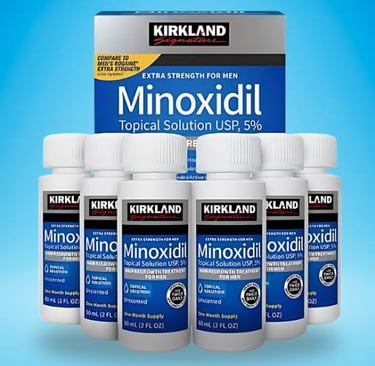Minoxidil for hair regrowth: A Comprehensive Guide
Discover how minoxidil stimulates hair regrowth, prevents hair loss, and revitalizes dormant follicles. Learn benefits, tips, and results of this proven treatment Minoxidil for hair regrowth
5/8/20243 min read
Hair loss is a concern for millions of individuals worldwide, affecting self-esteem and confidence. Among the many solutions available, minoxidil has stood out as one of the most effective and widely used treatments. This article explores everything you need to know about minoxidil, including its history, how it works, benefits, side effects, and tips for usage.
What is Minoxidil?
Minoxidil is a topical medication designed to stimulate hair growth and slow balding. Initially developed in the 1960s as an oral drug to treat high blood pressure, researchers noticed an interesting side effect—hair regrowth. This discovery led to the creation of topical minoxidil, marketed specifically for combating hair loss.
Minoxidil is available in various concentrations, typically 2%, 5%, and more recently, 10% or 15%, which are used for more severe cases of hair thinning.
---
How Does Minoxidil Work?
The precise mechanism behind minoxidil's effectiveness in promoting hair growth isn't entirely understood. However, it is believed to work in the following ways:
1. Vasodilation: Minoxidil widens blood vessels, improving blood flow to hair follicles. This increased blood supply delivers essential nutrients and oxygen, encouraging follicle health and hair growth.
2. Prolonging the Anagen Phase: Hair growth occurs in cycles, with the anagen phase being the active growth phase. Minoxidil extends this phase, allowing hair strands to grow longer and thicker.
3. Follicle Stimulation: Minoxidil stimulates dormant hair follicles, reactivating their growth.
---
Who Can Benefit from Minoxidil?
Minoxidil is most effective for individuals experiencing certain types of hair loss:
Androgenetic Alopecia (Male and Female Pattern Baldness): This hereditary condition is the most common form of hair loss, and minoxidil is FDA-approved to treat it.
Alopecia Areata: In some cases, individuals with this autoimmune condition may benefit from minoxidil.
Telogen Effluvium: This temporary form of hair loss, often triggered by stress or illness, may respond to minoxidil.
Minoxidil is less effective for individuals who have been bald for many years or who suffer from scarring alopecia.
---
Types of Minoxidil Products
Minoxidil is available in various formulations:
1. Topical Solution: A liquid applied directly to the scalp, usually twice a day.
2. Foam: A lightweight, quick-drying option, often preferred for ease of application.
3. Sprays and Serums: Targeted options for specific scalp areas.
Higher concentrations, such as 10% or 15%, are generally available as part of specialized treatments and are recommended only under medical supervision.
---
Benefits of Minoxidil
Improves Hair Density: Over time, minoxidil can increase the thickness and density of hair.
Slows Hair Loss: Regular use can reduce the progression of hair thinning.
Easy to Use: Topical application makes it a convenient option for daily routines.
Clinically Proven: Numerous studies have demonstrated its effectiveness in treating hair loss.
---
Potential Side Effects
Like any medication, minoxidil may cause side effects, though they are generally mild:
Scalp Irritation: Redness, itching, or dryness may occur in some users.
Shedding Phase: During the initial weeks of use, you might notice increased hair shedding. This is temporary and signals new growth.
Unwanted Hair Growth: In rare cases, minoxidil may stimulate hair growth on areas like the forehead or face.
Dizziness or Heart Palpitations: These symptoms are more common with oral minoxidil but can occasionally occur with topical use.
If side effects persist, consulting a dermatologist is essential.
---
Tips for Effective Use
1. Be Consistent: Apply minoxidil as directed, usually twice daily, to see the best results.
2. Be Patient: Results typically appear after 3–6 months of consistent use.
3. Target the Scalp: Focus application directly on the scalp rather than the hair.
4. Avoid Washing Too Soon: Allow at least four hours for the solution to absorb before washing your hair.
5. Consult a Doctor: Before starting higher concentrations like 10% or 15%, seek professional advice.
---
How Long Should You Use Minoxidil?
Minoxidil is a long-term treatment. If you stop using it, hair loss will likely resume. Most users incorporate it into their daily routine to maintain results.
---
Alternatives to Minoxidil
While minoxidil is effective, it isn’t the only solution for hair loss:
Finasteride: A prescription oral medication for male pattern baldness.
Low-Level Laser Therapy (LLLT): A non-invasive treatment that uses light to stimulate hair follicles.
Hair Transplants: A surgical option for severe cases of hair loss.
Natural Remedies: Essential oils like rosemary and peppermint may support scalp health, though they lack the scientific backing of minoxidil.
---
Frequently Asked Questions
1. Can women use minoxidil?
Yes, minoxidil is approved for women, though the 2% or 5% concentration is typically recommended.
2. Can I use minoxidil with other treatments?
Minoxidil can often be combined with finasteride, microneedling, or laser therapy for enhanced results.
3. Is minoxidil safe for long-term use?
Yes, studies show that it is safe when used as directed over many years.


